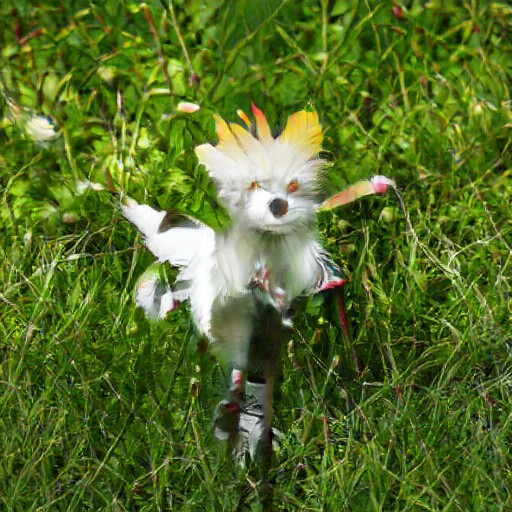Why Is This Viral Image of Unrecognizable Objects So Creepy?
What do you see in this image? Viewers are finding it virtually impossible to identify any of the almost-familiar objects in the picture — and it's freaking them out.
Twitter user @melip0ne shared the image on Tuesday (April 22) with this challenge: "Name one thing in this photo." It has since generated thousands of bewildered replies and outlandish guesses.
The image isn't just stumping viewers; it's also making some of them very uneasy, leading to comments such as "i feel so uncomfortable," "This stresses me out" and "Thx losing my sanity now."
What exactly is pictured in this bizarre image, and why is it so unsettling? [Why CGI Humans Are Creepy, and What Scientists Are Doing about It]
Trying to interpret an ambiguous image like this sparks uncertainty, which can lead to feeling "creeped-out," Dr. Frank McAndrew, a professor of psychology at Knox College in Galesburg, Illinois, told Live Science in an email.
When a person is unsure if something could be harmful, it's normal to experience a sense of unease, McAndrew said. But clearly this image doesn't pose a threat, so what's going on?
"We also can get creeped out by confusing things that press competing buttons in our brain, making it hard for us to categorize or understand what we are looking at," he said.
Sign up for the Live Science daily newsletter now
Get the world’s most fascinating discoveries delivered straight to your inbox.
No matter how much your brain tries to make sense of the image, it just won't resolve into something familiar; this further intensifies feelings of discomfort, Dr. Steven Schlozman, an assistant professor of psychiatry at Harvard Medical School, told Live Science in an email.
"I think the creepiness comes from our brains' attempts at recognizing a pattern, zeroing in on that pattern, and then having the expected pattern continually disrupted by another recognizable pattern," Schlozman said.
"I swear I see a chimp in that photo. But then it becomes something else, and then something else. I can't complete the puzzle," he said. "I can get some of it, but never enough to know what I'm seeing."
Machine dreams
The viral picture was likely generated digitally by artificial intelligence (AI), said Janelle Shane, an electrical engineering researcher who trains neural networks — a type of AI that "learns" in a manner similar to a brain.
Shane told Live Science that she was "95% sure" this image was created by a neural network called BigGAN, an algorithm Google trained to compose detailed photos from scratch.
"This kind of neural net, called a Generative Adversarial Network (GAN), learns to generate images from thousands of example photos," Shane said. "It was trained to generate about 1,000 distinct categories of images, but a fun thing about GANs is that you can also ask them to generate images that are a mix of categories," she said.
The objects are unrecognizable because they don't exist in the real world. Rather, they're digital composites of multiple objects that have been smushed together by the algorithm.
In fact, Shane previously wrote about BigGAN doing just that on her blog, AI Weirdness. Tweaking parameters in a model that generates images of dogs and flowers, for example, can result in a delightful crop of dogflowers.

Shane reviewed the Twitter picture using image-recognition AIs that had been trained on the same data set as BigGAN; they determined that the oddball "objects" were likely derived from images categories such as toy shop, bakery and grocery store, she wrote in a series of tweets.
AI doesn't always fail so miserably at creating realistic scenes. A neural network called StyleGAN recently generated astonishingly realistic photos of human faces (though its efforts to re-create cats were frankly horrifying). Often, AI's interpretation of our world can be similar enough to be familiar and different enough to cause unease, "which is what makes AI-generated images so deeply unsettling," Shane said.
"We see our world reflected back to us via something that is great at textures and lighting but doesn't understand the basics of how objects work."
For those who enjoy being creeped out and want to create their own nightmare-triggering images, they can do so with the online AI art tool Ganbreeder, Shane added.
- 5 Intriguing Uses for Artificial Intelligence (That Aren't Killer Robots)
- Can Machines Be Creative? Meet 9 AI 'Artists'
- Artificial Intelligence: Friendly or Frightening?
Originally published on Live Science.

Mindy Weisberger is an editor at Scholastic and a former Live Science channel editor and senior writer. She has reported on general science, covering climate change, paleontology, biology and space. Mindy studied film at Columbia University; prior to Live Science she produced, wrote and directed media for the American Museum of Natural History in New York City. Her videos about dinosaurs, astrophysics, biodiversity and evolution appear in museums and science centers worldwide, earning awards such as the CINE Golden Eagle and the Communicator Award of Excellence. Her writing has also appeared in Scientific American, The Washington Post and How It Works Magazine. Her book "Rise of the Zombie Bugs: The Surprising Science of Parasitic Mind Control" will be published in spring 2025 by Johns Hopkins University Press.










